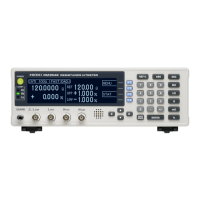Appendix 2 Effect of Thermal emf
A2
Thermal emf is the potential difference that occurs at
the junction of two dissimilar metals, which if suffi-
ciently large, can cause erroneous measurements.
Because this instrument functions by measuring
potential difference while applying a constant direct
current through the test object, the effect of thermal
emf can affect measurements. The amplitude of ther-
mal emf depends on the temperature of the measure-
ment environment, with the force generally being
greater at higher temperature.
Thermal emf typically occurs at any junction of dissim-
ilar metals, including between the test probe tips and
the test object.
Measurement discrepancy caused by thermal emf:
(Example)
If the amplitude of electromotive force is 10 V and the resistance to be measured is 1 , the measurement
current of the LP 1 range is 10 mA, and the actual measured value displayed on the instrument is as follows:
(1 x 10 mA + 10 V) ÷ 10 mA = 1.00100
The offset voltage compensation (OVC) function is enabled in the ranges from 100 m to 10 and when
using low-power resistance measurement, to minimize the effect of thermal emf.
OVC employs the principle that the following value is known to be a true resistance value from R
P
(>0), the
value measured with current flowing in the positive direction, and R
N
(<0), the value measured with current
flowing in the negative direction.
(R
N
is a negative value)
When the test object is inductive, some delay (DELAY2) must be set (p. 42) to allow adequate current flow
before starting measurement.
Set the delay so that inductance does not affect measurements.
To fine tune the delay, begin with a longer delay than necessary, then gradually shorten it while watching the
measured value.
Appendix 2 Effect of Thermal emf
RM3542
Metal A
Metal B
Thermal emf
R
p
R
N
–
2
----------------------

